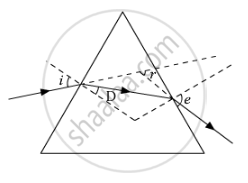Advertisements
Advertisements
प्रश्न
If a monochromatic beam of light undergoes minimum deviation through an equiangular prism, how does the beam pass through the prism, with respect to its base?
A beam of monochromatic light undergoes minimum deviation through an equiangular prism. How does the beam pass through the prism with respect to its base ?
उत्तर
It passes parallel with respect to the base of the prism.
APPEARS IN
संबंधित प्रश्न
After tracing the path of a ray of light through a glass prism a student marked the angle of incidence (∠i), angle of refraction (∠r) angle of emergence (∠e) and the angle of deviation (∠D) as shown in the diagram. The correctly marked angles are :

(A) ∠i and ∠r
(B) ∠i and ∠e
(C) ∠i, ∠e and ∠D
(D) ∠i, ∠r and ∠e
The coloured light having the maximum speed in glass prism is:
(a) blue
(b) green
(c) violet
(d) yellow
When white light passes through a prism, it ............
The property of splitting of white light into its seven constituent colours is known as
How does the speed of light determine the optical density of a medium?
Which is optically denser: water or air? Give reason
What conclusion do you draw about the nature of white light in part (b)?
What do you understand by the term spectrum?
Distinguish between an impure spectrum and a pure spectrum.
What is dispersion? Explain in detail.
